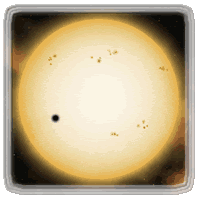| object | picture | age | size | otherinfo | distance |
|---|---|---|---|---|---|
| initial collapse of a molecular cloud (phase 2 of stellar birth) | |||||
| B335 |  |
105 years | cloud size = 6000 au | core mass = 0.4 mass(sun) | |
| EGGs... are these a special case? | |||||
| Evaporating Gaseous Globules |  |
Eagle nebula is 2 x 106 yrs old | each EGG is 50-100 au | uv starlight from upper right is evaporating the birth trappings of the central protostar | 7000 c-yr |
| in the Eagle Nebula | |||||
| EGGs will live only 10,000 more years | |||||
| the Herbig-Haro objects: jets and disks (phase 3 of the starbirth process) | |||||
| HH30 jet&disk |  |
age of the jet = 20,000 yr | disk = 500 au | jet velocity = 300 km/s | 450 c-yr |
| jet = 1600 au | |||||
| HH34 jet |  |
jet = 5000 au | jet velocity = 200 km/s | 1500 c-yr | |
| HH47 jet | jet = 30,000 au = .5 c-yr | 1500 c-yr | |||
| HH1-2 jet |  |
jet = 1 c-yr | 1500 c-yr | ||
| the Orion proplyds: disks without jets (phase 4 of stellar birth) | |||||
| Orion edge-on proplyd (star hidden by dust) |  |
105-106 yr | disk = 1400 au | 1500 c-yr | |
| Orion face-on proplyd with star visible in center |  |
106 years | disk = 600 au | mass(protostar)/mass(sun) = 1.2 | 1500 c-yr |
| Orion mosaic |  |
105-106 yrs | disk diameters = 100 - 1400 au | mass(protostars)/mass(sun) = 0.3 - 1.5
mass(disks)/mass(earth) = 0.1 - 700 |
1500 c-yr |
| containing 153 proplyds like these |  |
disk diameters = 150 - 650 au | |||
| planet building: protostars or young main sequence stars with disks which may contain protoplanetary objects (early phase 5 of stellar birth) | |||||
| Warped disk around Beta Pictoris | 100 million yrs | disk diameter = 1000 au | pink-white inner disk is tilted slightly to red-yellow-green outer disk | 50 c-yr | |
| may indicate presence of a planet | disk thickness = 10 au | warping planet sweeps out 25 au clear zone around star | |||
| planet mass = 0.05 - 20 mass(jupiter) | |||||
| medium-old main sequence stars with disks
containing
planetary- or comet-like objects |
|||||
| comets in the inner Kuiper belt |  |
4.5 billion years | diameter = 60 - 200 miles | about 500 discovered so far | 50 - 500 au? |
| there may be 200 million of these in the inner Kuiper belt | |||||
| Pluto, its companion Charon, and other dwarf planets |
 |
4.5 billion years | Pluto's diameter = 2300 km | Pluto is probably the largest and nearest of the comet-like objects in the Kuiper belt | 40 au from the sun or more |
| Charon's diameter = 1300 km | |||||
| planets around other sun-like stars |
 |
and now 200 extra-solar planets (around stars like the sun)! |
|||